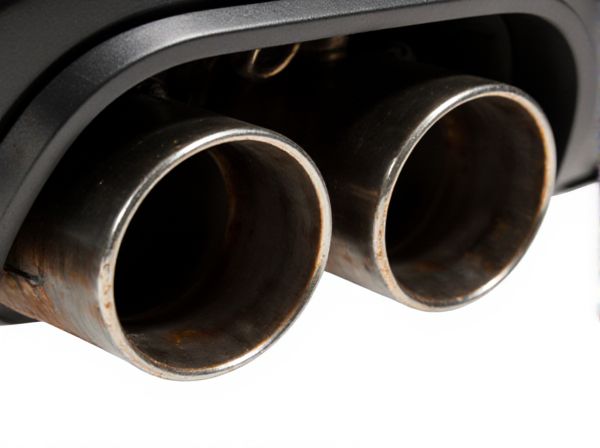
Photo illustration: Chambered Muffler vs Straight-through Muffler
A chambered muffler uses a series of internal chambers to reflect sound waves and reduce noise by canceling certain frequencies, providing a deeper tone and quieter operation. A straight-through muffler features a straight perforated pipe covered with sound-absorbing material, designed to maximize exhaust flow and increase performance while producing a louder, more aggressive sound. Choosing between the two depends on whether you prioritize noise reduction and smooth sound or enhanced engine output and sportier exhaust notes for your vehicle.
Table of Comparison
| Feature | Chambered Muffler | Straight-through Muffler |
|---|---|---|
| Design | Multi-chamber sound wave reflection | Perforated straight pipe with sound-absorbing material |
| Noise Reduction | Moderate to high noise dampening | Lower noise suppression, louder sound |
| Performance Impact | May slightly restrict airflow, less horsepower | Optimized for maximum airflow and power |
| Sound Profile | Deep, throaty, and quieter exhaust note | Aggressive, louder, high-performance tone |
| Fuel Efficiency | Standard fuel consumption | Potential improvement due to better exhaust flow |
| Cost | Generally lower cost | Usually higher cost due to materials and design |
| Best Use | Daily driving, noise-sensitive environments | Performance vehicles, racing, enthusiasts |
Introduction to Muffler Designs
Chambered mufflers utilize a series of internal chambers to reflect and cancel sound waves, effectively reducing noise while maintaining a deep exhaust tone. Straight-through mufflers feature a perforated core wrapped in sound-absorbing material, allowing exhaust gases to flow freely for increased performance and a louder exhaust note. Both designs cater to different priorities, with chambered mufflers emphasizing noise reduction and straight-through mufflers enhancing exhaust flow and engine output.
What is a Chambered Muffler?
A chambered muffler utilizes a series of internal chambers to reflect and cancel sound waves, effectively reducing exhaust noise while maintaining back pressure for engine performance. Its design involves strategically placed baffles and partitions that create pockets where sound waves interfere with each other, resulting in quieter operation. This muffler type is favored in muscle cars and classic vehicles for delivering a deep, throaty exhaust tone without excessive noise.
What is a Straight-through Muffler?
A straight-through muffler features a perforated core wrapped in sound-absorbing materials designed to reduce exhaust noise with minimal restriction. It allows exhaust gases to flow more freely compared to chambered mufflers, enhancing engine performance and improving horsepower. This design is favored in high-performance and racing applications for its balance of sound reduction and increased exhaust flow efficiency.
Sound Differences: Chambered vs Straight-through
Chambered mufflers produce a deep, throaty sound by using internal chambers to reflect and cancel specific sound frequencies, resulting in a more refined and louder exhaust note. Straight-through mufflers feature a straight perforated pipe wrapped in sound-absorbing material, allowing exhaust gases to flow freely and generate a more aggressive, high-pitched tone with minimal restriction. The choice between chambered and straight-through mufflers significantly influences the vehicle's acoustic profile, with chambered designs emphasizing bass-rich sound and straight-through designs maximizing performance-driven noise.
Performance Impact and Power Gains
Chambered mufflers create pressure waves that enhance low-end torque by reflecting exhaust pulses, improving engine scavenging but often restricting high-RPM power due to increased backpressure. Straight-through mufflers feature a perforated core wrapped in sound-absorbing material, minimizing backpressure and promoting better high-RPM horsepower and acceleration gains. Performance gains with chambered mufflers are typically seen in torque-rich applications, while straight-through designs are preferred for maximizing overall power and top-end efficiency.
Durability and Material Considerations
Chambered mufflers are typically constructed from thicker steel or aluminized steel, providing enhanced durability and resistance to corrosion, making them suitable for everyday driving conditions. Straight-through mufflers often utilize stainless steel or high-grade alloys, which offer superior longevity and better heat dissipation, ideal for high-performance and racing applications. Material choice significantly impacts the muffler's lifespan, with stainless steel variants generally outperforming chambered mufflers in harsh environments due to their corrosion resistance and structural integrity.
Installation Complexity and Fitment
Chambered mufflers typically have a more complex internal design with multiple chambers, resulting in a heavier structure that may require precise mounting points and potential modifications for proper fitment. Straight-through mufflers feature a simpler, linear design with a perforated core wrapped in sound-absorbing material, generally offering easier installation and a more universal fit for various exhaust systems. Vehicle-specific parameters such as pipe diameter, hanger locations, and available clearance dictate the final installation complexity and compatibility of either muffler type.
Legal and Noise Compliance Issues
Chambered mufflers often provide a deeper tone but may struggle to meet stringent noise regulations due to their design causing variable sound output levels. Straight-through mufflers typically maintain a consistent noise reduction, making them more likely to comply with legal noise limits set by transportation authorities. Vehicle owners should verify local laws to ensure their muffler choice adheres to sound decibel restrictions and emissions standards.
Cost Comparison: Which Is More Affordable?
Chambered mufflers generally cost less upfront, ranging from $50 to $150, making them a budget-friendly option for noise reduction. Straight-through mufflers, designed for performance and improved exhaust flow, typically cost between $100 and $300 but can lead to better fuel efficiency and engine power. Considering installation and maintenance, chambered mufflers remain more affordable for standard use, while straight-through mufflers are an investment geared towards performance gains.
Choosing the Right Muffler: Key Considerations
Chambered mufflers offer sound dampening with distinct exhaust pulses, making them ideal for drivers seeking a deep, throaty tone and improved low-end torque, while straight-through mufflers prioritize maximum exhaust flow for enhanced horsepower and a louder, more aggressive sound. Selecting the right muffler depends on desired performance outcomes, noise preference, and vehicle application, with chambered designs favoring street use and straight-through styles often preferred for racing and high-performance setups. Key considerations include noise regulations, engine tuning, and how the muffler's flow characteristics affect overall backpressure and efficiency.
 caratoz.com
caratoz.com